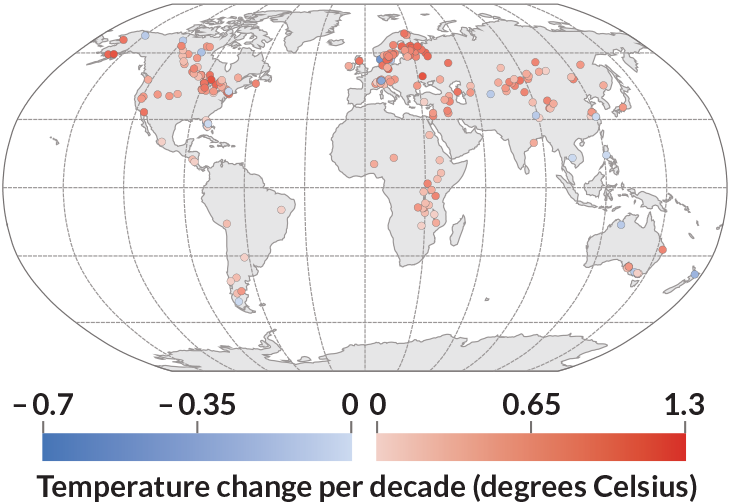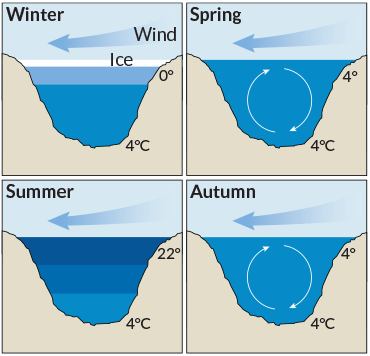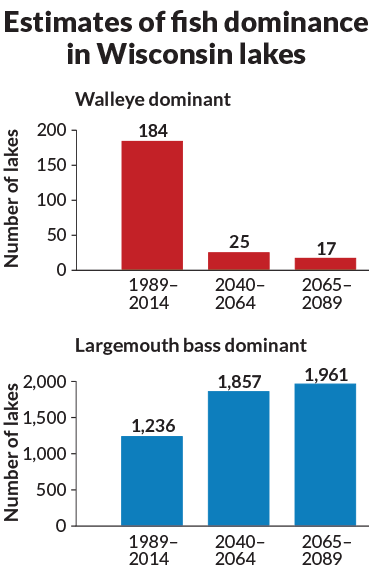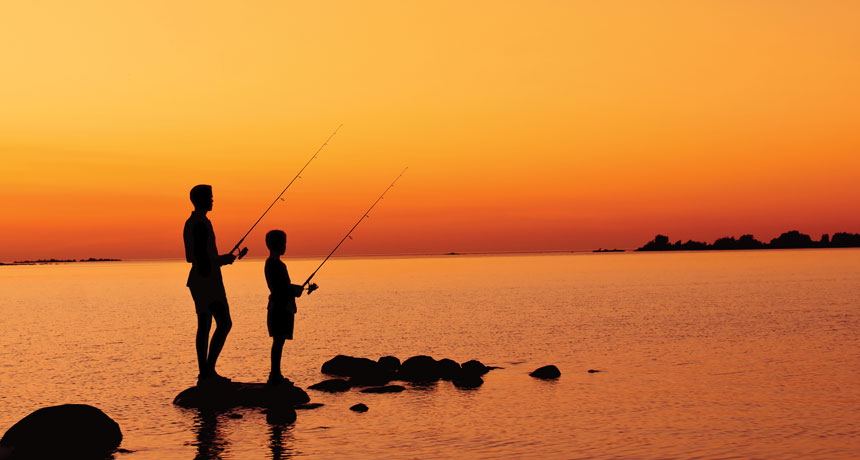
HOT WATER Oceans aren’t the only bodies of water affected by climate change. Lake Huron (shown) and many lakes worldwide could experience ecological, recreational and economic impacts from warming.
AlpamayoPhoto/Getty
About 40 kilometers off Michigan’s Keweenaw Peninsula, in the waters of Lake Superior, rises the stone lighthouse of Stannard Rock. Since 1882, it has warned sailors in Great Lakes shipping lanes away from a dangerous shoal. But today, Stannard Rock also helps scientists monitor another danger: climate change.
Since 2008, a meteorological station at the lighthouse has been measuring evaporation rates at Lake Superior. And while weather patterns can change from year to year, Lake Superior appears to be behaving in ways that, to scientists, indicate long-term climate change: Water temperatures are rising and evaporation is up, which leads to lower water levels in some seasons. That’s bad news for hydropower plants, navigators, property owners, commercial and recreational fishers and anyone who just enjoys the lake.
When most people think of the physical effects of climate change, they picture melting glaciers, shrinking sea ice or flooded coastal towns (SN: 4/16/16, p. 22). But observations like those at Stannard Rock are vaulting lakes into the vanguard of climate science. Year after year, lakes reflect the long-term changes of their environment in their physics, chemistry and biology. “They’re sentinels,” says John Lenters, a limnologist at the University of Wisconsin–Madison.
Story continues after image
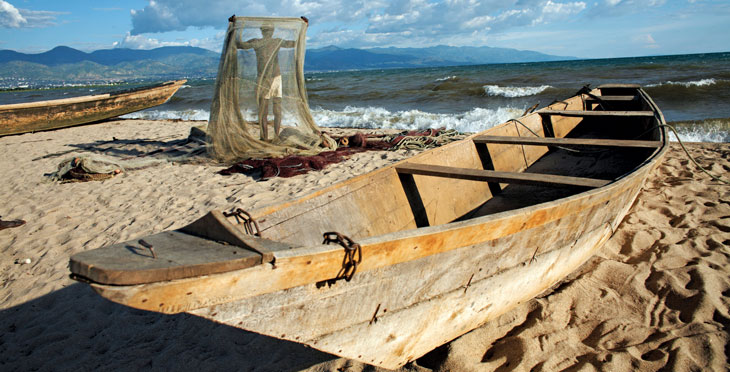
Globally, observations show that many lakes are heating up — but not all in the same way or with the same ecological consequences. In eastern Africa, Lake Tanganyika is warming relatively slowly, but its fish populations are plummeting, leaving people with less to eat. In the U.S. Upper Midwest, quicker-warming lakes are experiencing shifts in the relative abundance of fish species that support a billion-dollar-plus recreational industry. And at high global latitudes, cold lakes normally covered by ice in the winter are seeing less ice year after year — a change that could affect all parts of the food web, from algae to freshwater seals.
Understanding such changes is crucial for humans to adapt to the changes that are likely to come, limnologists say. Indeed, some northern lakes will probably release more methane into the air as temperatures rise — exacerbating the climate shift that is already under way.
Lake layers
Lakes and ponds cover about 4 percent of the land surface not already covered by glaciers. That may sound like a small fraction, but lakes play a key role in several planetary processes. Lakes cycle carbon between the water’s surface and the atmosphere. They give off heat-trapping gases such as
carbon dioxide and methane, while simultaneously tucking away carbon in decaying layers of organic muck at lake bottoms. They bury nearly half as much carbon as the oceans do.
Yet the world’s more than 100 million lakes are often overlooked in climate simulations. That’s surprising, because lakes are far easier to measure than oceans. Because lakes are relatively small, scientists can go out in boats or set out buoys to survey temperature, salinity and other factors at different depths and in different seasons.
A landmark study published in 2015 aimed to synthesize these in-water measurements with satellite observations for 235 lakes worldwide. In theory, lake warming is a simple process: The hotter the air above a lake, the hotter the waters get. But the picture is far more complicated than that, the international team of researchers found.
Story continues after map
On average, the 235 lakes in the study warmed at a rate of 0.34 degrees Celsius per decade between 1985 and 2009. Some warmed much faster, like Finland’s Lake Lappajärvi, which soared nearly 0.9 degrees each decade. A few even cooled, such as Blue Cypress Lake in Florida. Puzzlingly, there was no clear trend in which lakes warmed and which cooled. The most rapidly warming lakes were scattered across different latitudes and elevations.
Even some that were nearly side by side warmed at different rates from one another — Lake Superior, by far the largest of the Great Lakes, is warming much more rapidly, at a full degree per decade, than others in the chain, although Huron and Michigan are also warming fast.
“Even though lakes are experiencing the same weather, they are responding in different ways,” says Stephanie Hampton, an aquatic biologist at Washington State University in Pullman.
Such variability makes it hard to pin down what to expect in the future. But researchers are starting to explore factors such as lake depth and lake size (intuitively, it’s less teeth-chattering to swim in a small pond in early summer than a big lake).
Depth and size play into stratification, the process through which some lakes separate into layers of different temperatures. Freshwater is densest at 4° C, just above freezing. In spring, using the Great Lakes as an example, the cold surface waters begin to warm; when they reach 4°, they become dense enough to sink. The lake’s waters mix freely and become much the same temperature at all depths.
But then, throughout the summer, the upper waters heat up relatively quickly. The lake stops mixing and instead separates into layers, with warm water on top and cold, dense water at the bottom. It stays that way until autumn, when chilly air temperatures cool the surface waters to 4°. The newly dense waters sink again, mixing the lake for the second time of the year.
Lake Superior is warming so quickly because it is stratifying earlier and earlier each year. It used to separate into its summer layers during mid- to late July, on average. But rising air temperatures mean that it is now stratifying about a month earlier — giving the shallow surface layers much more time to get toasty each summer. “If you hit that starting point in June, now you’ve got all summer to warm up that top layer,” Lenters says.
Deep lakes warm very slowly in the spring, and small changes in water temperature at the end of winter can lead to large changes in the timing of summer stratification for these lakes. Superior is about 406 meters deep at its greatest point, so it is particularly vulnerable to such shifts.
In contrast, shallow lakes warm much more quickly in the spring, so the timing of their summer stratification is much less variable than for deep lakes. Lake Erie is only 64 meters deep at its maximum, which is why Erie is not experiencing big changes in its stratification start date. Erie is warming one-tenth as fast as Superior, just 0.1 degrees per decade.
Superior is also warming because of a decline in cloud cover over the Great Lakes in recent years; more heat from solar radiation hits the lakes, Lenters said at a limnology meeting in Honolulu in March. Why the cloud cover is changing isn’t known — it could be natural variability. But the increased sunlight means another source of warming for Superior and the other Great Lakes.
On top of that, evaporation, measured from spots like Stannard Rock, also plays into the complexity. High evaporation rates in a warm autumn can actually lead to more ice cover the following winter and slower ice breakup in the spring, because the water is colder after evaporation. “When lakes sweat, they cool off,” Lenters says. All these factors conspire to complicate the picture of why Superior is warming so quickly, and what people in the Great Lakes region can do about it.
A new reality
Warming water — even small changes — can have a big impact on a lake’s ecology. One of the most famous examples is Lake Tanganyika in eastern Africa. It has been warming relatively slowly, about 0.2 degrees per decade. But that is enough to make it more stratified year-round and less likely to mix. With layers stagnating, nutrients that used to rise from the bottom of the lake become trapped down low, Hampton says.
With fewer nutrients reaching the upper waters, lake productivity has plummeted. Since the late 1970s, catches of sardines and sprats have declined by as much as 50 percent, and the hundreds of thousands of people who depend on the lake for food have had to find additional sources of protein. Factors such as overfishing may also play a role, but a study published last August in Proceedings of the National Academy of Sciences found that lake temperatures in the last century were the highest of at least the previous 500 years.
Elsewhere, lake warming seems to be shifting the relative abundances of fish within certain lakes. This is apparent in a study of walleye (Sander vitreus), a popular recreational fishing target in the lakes of the U.S. Upper Midwest.
In Wisconsin, recreational freshwater fishing brings in more than $1.5 billion annually. So officials were worried when, around 2000, anglers and biologists began reporting that walleye numbers seemed to be dropping.
“We’ve seen declines in some of our most valuable fish,” says Jordan Read, a limnologist at the U.S. Geological Survey in Middleton, Wis. Hoping to figure out why, Read and colleagues analyzed water temperatures in 2,148 Wisconsin lakes from 1989 to 2014. Some of these lakes had seen populations of walleye drop as populations of largemouth bass (Micropterus salmoides) increased. Largemouth bass are also popular catches, although not as popular as walleye.
The scientists simulated how lake temperatures would probably rise through the year 2089 and how that might affect walleye survival in the state’s lakes. The team used a measure that describes whether walleye can spawn and their young can survive in a particular environment, compared with the relative abundance of largemouth bass. Up to 75 percent of the lakes studied would no longer be able to support young walleye by 2089, while the number of lakes that could support lots of bass could increase by 60 percent, the researchers estimate in the April Global Change Biology.
“Bass and walleye seem to be responding to the same temperature threshold but in opposite directions,” says Gretchen Hansen, a fisheries scientist at the Minnesota Department of Natural Resources in St. Paul who led the work.
The reason isn’t yet clear. Physiologically, walleye should still be able to survive in the higher temperatures. But something is already causing them to wane — perhaps they have fewer food sources, or they spawn less successfully. Field studies are under way to try to answer that question, Hansen says.
Variability in lake warming offers hope for the walleye. The study identified lakes where the walleye might be able to hold on. Some of these places have warmed less than others, making them more amenable to walleye, even as largemouth bass take over other lakes.
If the researchers can identify lakes that are likely to keep walleye healthy in the future, then officials can foster walleye spawning in those places and keep the state’s fishing industry healthy for decades to come. “While the outlook isn’t great, there are … lakes that are a good target of management action,” Read says. The scientists are now expanding their analysis into Minnesota and other neighboring states.
Less ice
Ecological changes put into motion during a particularly cold or hot time can send ripples during the following seasons, researchers are finding. “What happens in previous seasons sometimes matters more than the current season,” Lenters says. This is especially true for lakes at high latitudes that are covered in ice each winter but may see less ice as temperatures rise. Ice acts as an insulator, protecting the waters from big changes in the air temperature above. When the ice finally melts in spring, the water is exposed to warming from the atmosphere and from sunlight. “It’s a way the temperature can really rapidly increase in those lakes,” Hampton says.
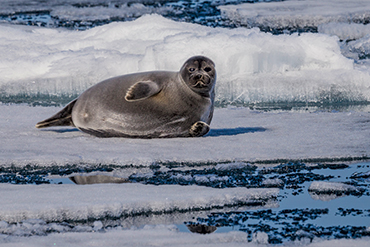
More broadly, and at other lakes, big questions remain about how winter and summer ecosystems connect. Biologists are assessing what wintertime ecosystems look like now, as a framework for understanding future change.
In a survey of 101 ice-covered lakes, Hampton and colleagues found more plankton under the ice than they had expected; chlorophyll levels were 43 percent of what they were in the summer. “It surprised me it was that high,” she says. “Some of these are snow-covered lakes not getting a lot of light.” The team reported its puzzling findings in January in Ecology Letters.
As winter shortens, fish may find more nutrients available to them earlier in the year than usual. Other algae-grazing creatures may become more abundant as the food web adjusts to what’s available with less ice cover.
More methane
Warming lakes themselves might exacerbate climate change. As temperatures rise, methane from microbes called archaea at the lake’s bottom bubbles up through the water column — particularly in northern lakes — and adds to the atmosphere’s greenhouse gas load.
At the Honolulu meeting, biogeochemist Tonya DelSontro of the University of Quebec in Montreal reported on methane release from boreal lakes, those lying between 50° and 70° N in realms such as Canada and Siberia. The boreal region contains up to half of the world’s carbon, with lakes an important source and sink.
DelSontro simulated how the boreal zone’s 9 million lakes would behave in the future. Just a 1 degree rise in surface temperature would boost methane emissions from boreal lakes by about 10 percent, DelSontro found. That’s not taking into account other factors such as a lengthening of the ice-free season, which would also put more methane into the air.
And at the University of Exeter in England, lake expert Gabriel Yvon-Durocher has been working to measure, on a small scale, how exactly ponds and lakes will respond to rising temperatures. His team built a series of experimental ponds, each of which is warmed by a certain temperature range over a certain period of time.
After heating the ponds by 4 to 5 degrees over seven years, the scientists found the lakes’ methane emissions more than doubled. In the same period, the ability to suck down carbon dioxide was cut almost by half. Such shifts could make climate change even worse, the team wrote in February in Nature Climate Change.
With so much variability among lakes, and so much uncertainty remaining about where they may head in the future, Lenters argues that limnologists need to keep gathering as much information as possible. Just as the Stannard Rock lighthouse is providing key data on Lake Superior, other locations need to be pressed into service to keep an eye on what lakes are doing. “There are aspects of the Pacific Ocean we know better than Lake Superior,” he says. “Lakes are woefully understudied.”
This article appears in the May 13, 2017, issue of Science News with the headline, “In hot water: Warming lakes have ecological and human effects.”
Editor’s Note: This article was updated on June 9, 2017, to correct a statement about rising methane production at the bottom of lakes when temperatures rise. Rather than bacteria, all known methane-producing organisms are archaea.
